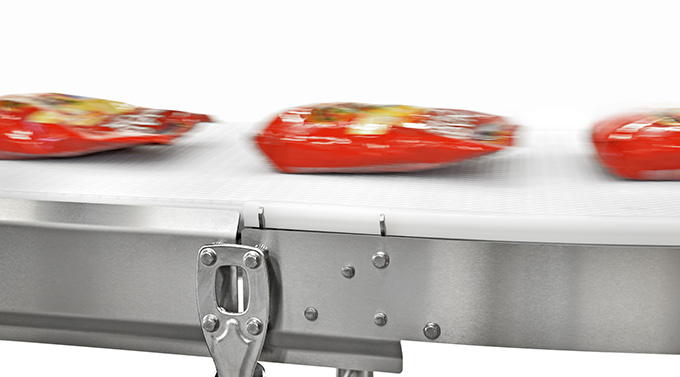
Automated production flow solutions can differ tremendously depending on production and needs. They can consist of one conveyor connecting two machines together, or a mix of different lines, machines, elevators and robots. Irrespective of size, the goal of an automated production line creates an excellent workflow. In this article, I will describe some of the most important aspects to consider when implementing it, to make the process as efficient as possible.
Automated production flow solutions can create an optimal manufacturing flow
 A fully automated production flow solution can create an excellent flow throughout the whole production. An optimal flow often includes several manufacturing machines that are linked together through a system of conveyors. The conveyors distribute the products evenly on the production line at a pace that is adapted to the production. The implementation process consists of several steps and there are many things to keep in mind to be as efficient and successful as possible.
A fully automated production flow solution can create an excellent flow throughout the whole production. An optimal flow often includes several manufacturing machines that are linked together through a system of conveyors. The conveyors distribute the products evenly on the production line at a pace that is adapted to the production. The implementation process consists of several steps and there are many things to keep in mind to be as efficient and successful as possible.
Simplify the implementation by using standard contractual conditions
 The first step is to design an application. The application is based on the supplier’s suggestions of the most suitable production flow solution for that specific customer’s needs. When the customer approves and places an order, one of the first things to do together with the customer is to establish a contract and contractual conditions. The contractual conditions include the rights and obligations of both the customer and the supplier. The conditions cover for example how the installation process should be handled as well as milestones and economic reference points. It is recommended to use a standard contract to simplify the process as much as possible. Special conditions and exceptions can in worst case delay parts of the implementation, which can affect the whole process in a negative way. A standard contract provides a common basis and understanding that is a great help for both the supplier and the customer throughout the implementation project.
The first step is to design an application. The application is based on the supplier’s suggestions of the most suitable production flow solution for that specific customer’s needs. When the customer approves and places an order, one of the first things to do together with the customer is to establish a contract and contractual conditions. The contractual conditions include the rights and obligations of both the customer and the supplier. The conditions cover for example how the installation process should be handled as well as milestones and economic reference points. It is recommended to use a standard contract to simplify the process as much as possible. Special conditions and exceptions can in worst case delay parts of the implementation, which can affect the whole process in a negative way. A standard contract provides a common basis and understanding that is a great help for both the supplier and the customer throughout the implementation project.
Conduct a well thought out time plan early in the process
 Before implementing an automated production flow solution it is important to have a realistic approach regarding the project’s time plan in order to avoid delays. There are often several different suppliers that deliver equipment to the same production line. Therefore, all suppliers need to be coordinated so the different components are installed in the right order and at the right time. Since the conveyor system is connecting all the machines and components together, one should consider installing the conveyors last.
Before implementing an automated production flow solution it is important to have a realistic approach regarding the project’s time plan in order to avoid delays. There are often several different suppliers that deliver equipment to the same production line. Therefore, all suppliers need to be coordinated so the different components are installed in the right order and at the right time. Since the conveyor system is connecting all the machines and components together, one should consider installing the conveyors last.
Communication is key during the risk analysis
 One of the most important things to remember during an implementation of an automated production flow solution is to have a clear communication with all parties throughout the whole implementation process. An example where communication in an implementation process is key is in connection to the risk analysis, which is performed before installation. The risk analysis involves, for example, technical risks in the working environment such as heavy lifts. It also involves specific rules if the production plant is completely new. If the installation will take place in an already existing factory plant and there will be an ongoing production during the installation, the production staff needs to be aware of this, and that requires a high level of coordination. So, it is crucial that all parties involved in the implementation process are aware of the risks and rules coming from the risk analysis.
One of the most important things to remember during an implementation of an automated production flow solution is to have a clear communication with all parties throughout the whole implementation process. An example where communication in an implementation process is key is in connection to the risk analysis, which is performed before installation. The risk analysis involves, for example, technical risks in the working environment such as heavy lifts. It also involves specific rules if the production plant is completely new. If the installation will take place in an already existing factory plant and there will be an ongoing production during the installation, the production staff needs to be aware of this, and that requires a high level of coordination. So, it is crucial that all parties involved in the implementation process are aware of the risks and rules coming from the risk analysis.
A site acceptance test controls the performance of the production line
 After designing the automated production flow solution a factory acceptance test (FAT) is performed in the supplier’s premises, which the customer is invited to take part in. After the customer has approved the factory test, the equipment is packed and delivered to the customer. Upon arrival, an installation team unpacks and installs the production line for the customer.
After designing the automated production flow solution a factory acceptance test (FAT) is performed in the supplier’s premises, which the customer is invited to take part in. After the customer has approved the factory test, the equipment is packed and delivered to the customer. Upon arrival, an installation team unpacks and installs the production line for the customer.
After installation, the supplier offers education to the production staff in how the production flow solution works including all the features. The implementation process ends with a site acceptance test (SAT) testing the performance of the automated production flow solution. The test shows that the supplier has completed the delivery, and after the test is conducted and approved, the finalized automated production flow solution is handed over to the customer. For the automated production flow solution to have a long service life it is important that the solution gets proper service and maintenance. This is to avoid potential production stops that can cause financial damage to any manufacturing industry. Service and maintenance are either performed by the customer or it can be provided by FlexLink as a part of a service agreement.
Increase profit and product quality with robust production equipment
It is highly profitable to invest in an automated production flow solution in a manufacturing industry. The solution contributes to delivery assurance and a robust production flow. It also leads to high product quality since the production is performed in the exact same way regardless of production staff, time of the day or day of the week. Also, it is a flexible system that is easy to re-design and has a long service life. FlexLink’s automated production flow solutions are well proven, cost-effective as well as easy to install and maintain. In addition, they are flexible and can handle products in all sizes, from lipsticks to pallets with cartons. During an implementation, we have a tight dialogue with the customer to secure an automated production flow solution that fits them, their needs as well as their production. There is no manufacturing industry that we can’t design an automated production flow solution for. Put us to the test and we will prove it to you!
I hope you learned something new about automated production flow solutions and how to implement them. If you have any questions feel free to contact me directly. Or, you can visit our website for more information about FlexLink and our solutions. Don’t forget to check us out on social media!




Hi Börje
i have a doubt related to robots ,if the robots are closed loop system or responding type ,if its possible to make as closed system
If I understand the question correct – Yes, we have installed many production flow solutions including robots, where the conveyor system and the robots are synchronized using, more or less, standard communication protocols. For the FlexLink solutions it is most common that the conveyor PLC is master and the robot is slave.